Evaluation of Urban Resource Environmental Carrying Capacity and Land Spatial Development Suitability in a Semiarid Area of the Yellow River Basin
Abstract
1. Introduction
1.1. Research Purpose
1.2. Research Status at Home and Abroad
1.3. Highlights of Paper
2. Materials and Methods
2.1. Natural Overview of the Study Area
2.2. Data Sources
2.3. Double Evaluation Index System
2.3.1. Spatial Characteristics of Hohhot
2.3.2. Construction of Index System
2.4. Research Method
2.5. Technology Roadmap
3. Results
3.1. Evaluation of the Carrying Capacity of Resources and Environment
3.1.1. Evaluation of the Importance of Ecological Protection Function
Environmental Assessment of Single Element
Integrative Assessment
3.1.2. Evaluation of Agricultural Function Carrying Capacity
Environmental Assessment of Single Element
Integrative Assessment
3.1.3. Evaluation of Urban Functional Carrying Capacity
Environmental Assessment of Single Element
Integrative Assessment
3.2. Space Development Suitability Evaluation
3.2.1. Suitability Evaluation of Agricultural Production
Integrative Assessment
3.2.2. Suitability Evaluation of Urban Construction
Integrative Assessment
4. Discussion
5. Conclusions
6. Prospects
Author Contributions
Funding
Institutional Review Board Statement
Informed Consent Statement
Data Availability Statement
Conflicts of Interest
References
- Tang, C.H.; Fan, J.; Sun, W. Distribution characteristics and policy implications of territorial development suitability of the Yangtze River Basin. J. Geogr. Soc. China 2015, 25, 16. [Google Scholar] [CrossRef]
- Zhao, G.; Liang, R.; Li, K. Study on the coupling model of urbanization and water environment with basin as a unit: A study on the Hanjiang Basin in China. Ecol. Indic. 2021, 131, 108130. [Google Scholar] [CrossRef]
- Guo, K.; Zhang, X.; Liu, J. Establishment of an integrated decision-making method for planning the ecological restoration of terrestrial ecosystems. Sci. Total Environ. 2020, 741, 139852. [Google Scholar] [CrossRef] [PubMed]
- Jafari, S.; Zaredar, N. Development, Land Suitability Analysis using Multi Attribute Decision Making Approach. Int. J. Environ. Sci. Dev. 2010, 1, 441–445. [Google Scholar] [CrossRef]
- He, Y.D.; Wang, L.F.; Zhai, Y.B. Analysis on Environmental Carrying Capacity of Chang-Zhu-Tan City Group. Environ. Sci. Technol. 2010, 33, 401–404. [Google Scholar]
- Wang, Y.; Su, X.; Qi, L.; Liu, M. Evaluation of the Comprehensive Carrying Capacity of Interprovincial Water Resources in China and the Spatial Effect. J. Hydrol. 2019, 575. [Google Scholar] [CrossRef]
- Davidson, D.A.; Theocharopoulos, S.P. A land evaluation project in Greece using GIS and based on Boolean and fuzzy set methodologies. Int. J. Geogr. Inf. Syst. 1994, 8, 369–384. [Google Scholar] [CrossRef]
- Tian, H.L.; Qiao, J.P.; Zhu, B. Rapid evaluation of resources and environment carrying capacity in Chengdu disaster area based on GIS technology. Sichuan Univ. Nat. Sci. Ed. 2009, 41, 45–48. [Google Scholar]
- Wu, B. Evaluation of carrying capacity of resources and environment in Shenzhen based on principal component analysis. In Proceedings of the 2010 China Sustainable Development Forum, Jinan, China, 22 October 2010. [Google Scholar]
- Gao, R.Z.; Li, H.P.; Tong, C.F. Comprehensive evaluation and analysis of water resources carrying capacity in Ordos City. Soil Water Conserv. 2011, 18, 5. [Google Scholar]
- Wang, X.J.; Fu, X.; Sun, Y.J. Evaluation of carrying capacity of resources and environment in Ganzhou City based on GIS. J. Jiangxi Agric. Univ. 2013, 35, 8. [Google Scholar]
- Shao, Y.P.; Guo, Z.Y.; Bai, S.J. Resources, Evaluation of Resources and Environment Carrying Capacity and Optimization of Spatial Layout Based on GIS—Setting Rongcheng City as an Example. Shandong Land Resour. 2019, 35, 57–61. [Google Scholar]
- Liang, T.; Cai, C.X.; Liu, M. Study on methodology of ecological suitability assessment of urban landuse: An example of Pingxiang. Geogr. Study 2007, 26, 782–788. [Google Scholar]
- Tang, C.C.; Sun, W. Comprehensive evaluation of land spatial development suitability of the Yangtze River Basin. J. Geogr. Soc. China 2012, 67, 1587–1598. [Google Scholar]
- Huang, S.J.; Meng, X.B. Ecological suitability evaluation of Shishou City in Hubei Province based on GIS technology. Intell. Build. City Inf. 2021, 7, 34–35. [Google Scholar]
- Lee, D.; Oh, K. A Development Density Allocation Model based on Environmental Carrying Capacity. Int. J. Environ. Sci. Dev. 2012, 3, 486–490. [Google Scholar] [CrossRef]
- Xu, H.; Li, X.; Li, L. Evaluation of urban subsurface space development suitability in the city of Qingdao. In Proceedings of the 2010 The 2nd Conference on Environmental Science and Information Application Technology, Wuhan, China, 17–18 July 2010. [Google Scholar]
- Zheng, Y.; Li, R.R. Evaluation of Resource and Environment Carrying Capacity—Taking Si County of Anhui Province as an Example. Hit J. 2019, 28, 56–60. [Google Scholar]
- Zhang, B.W. Environmental landform and urban construction in Hohhot. J. Arid. Land Resour. Environ. 1993, 1, 9. [Google Scholar]
- Qin, Z. Analysis of climate change characteristics in Hohhot from 1988 to 2017. Mod. Agric. Sci. Technol. 2019, 2, 1. [Google Scholar]
- Qu, Y.; Zhang, F.; Jiang, G.; Guan, X.; Guo, L. Suitability evaluation and subarea control and regulation of rural residential land based on niche. Trans. Chin. Soc. Agric. Eng. 2010, 26, 290–296. [Google Scholar]
- Feng, Z.M.; Yang, Y.Z.; Yan, H.M.; Tao, P.; Peng, L. Research on the carrying capacity of resources and environment in the past century:from theory to practice. Resour. Sci. 2017, 39, 379–395. [Google Scholar]
- Li, M.; Liang, D.; Xia, J.; Song, J.; Cheng, D.; Wu, J.; Cao, Y.; Sun, H.; Li, Q. Evaluation of water conservation function of Danjiang River Basin in Qinling Mountains, China based on InVEST model. J. Environ. Manag. 2021, 286, 112212. [Google Scholar] [CrossRef] [PubMed]
- Akalu, T.; Jan, D.G.; Leo, S. Evaluation of soil and water conservation practices in the north-western Ethiopian highlands using multi-criteria analysis. Front. Environ. Sci. 2014, 2, 60. [Google Scholar]
- Manguin, S.; Boëte, C. The Importance of Biological Interactions in the Study of Biodiversity; BoD–Books on Demand: Norderstedt, Germany, 2011. [Google Scholar]
- Pandey, S.; Kumar, P.; Zlatic, M.; Nautiyal, R.; Panwar, V.P. Recent advances in assessment of soil erosion vulnerability in a watershed. Int. Soil Water Conserv. Res. 2021, 9, 305–318. [Google Scholar] [CrossRef]
- Marin, C.M.; Smith, M.G. Water-resources assessment—A spatial equilibrium approach. Water Resoures 1988, 24, 793–801. [Google Scholar] [CrossRef]
- Bhermana, A.; Sunarminto, B.H.; Utami, S.; Gunawan, T. The combination of land resource evaluation approach and gis application to determine prime commodities for agricultural land use planning at developed area (a case study of Central Kalimantan province, Indonesia). J. Agric. Biol. Sci. 2013, 8, 771–784. [Google Scholar]
- Oh, K.; Jeong, Y.; Lee, D.; Lee, W.; Choi, J. Determining development density using the Urban Carrying Capacity Assessment System. Landsc. Urban Plan. 2005, 73, 1–15. [Google Scholar] [CrossRef]
- Wang, D.H.; Li, X.D. Analysis of Resources and Environmental Carrying Capacity and Regional Coordinated Development in Mountainous Watershed: A Case Study of Wujiang River Basin in Guizhou. Environ. Sci. Technol. 2019, 43, 222–229. [Google Scholar]
- Liu, T.K.; Yuan, C.F. Thoughts on the importance evaluation of water conservation function based on GIS-Taking the Yellow River Basin in Henan Province as an example. Reg. Gov. 2020, 4, 3. [Google Scholar]
- Jiao, X.L. Study on the importance of soil and water conservation function based on ‘double evaluation’ of land and space planning-Taking Lingchuan County as an example. Nat. Resour. North China 2022, 1, 154–156. [Google Scholar]
- Xu, K.; Kong, C.; Li, J.; Zhang, L.; Wu, C. Suitability evaluation of urban construction land based on geo-environmental factors of Hangzhou, China. Comput. Geosci. 2011, 37, 992–1002. [Google Scholar] [CrossRef]
- Lei, Y. Evaluation of the importance of soil and water conservation function in Fujian Province based on GIS. Bull. Soil Water Conserv. 2020, 40, 7. [Google Scholar]
- Liu, T.K.; Xiao, J.C. Importance evaluation of biodiversity conservation function in the Yellow River Basin of Henan Province based on net primary productivity. Henan Sci. Technol. 2020, 16, 3. [Google Scholar]
- Du, H.E.; Li, Z.; Zheng, Y. Research progress on resource and environment carrying capacity evaluation and land space development suitability evaluation. Chin. Min. 2019, 28, 7. [Google Scholar]
- Zhong, Z.Q. Forestland Ecological Vulnerability Evaluation in Shunchang County, Fujian Province. J. Beihua Univ. 2017, 18, 395–400. [Google Scholar]
- Fang, Y.S.; Zu, J.; Ai, D.; Jie, C.; Qiuyue, L. Evaluation of the importance of ecological protection in Kunming for territorial spatial planning. J. China Agric. Univ. 2021, 26, 152–163. [Google Scholar]
- Wang, T.Y. Suitability evaluation of land space development and construction-Taking Fuxian County of Yan’an City as an example. Agric. Technol. 2021, 41, 8. [Google Scholar]
- Xu, Y.Y.; Yu, Y.; Li, C.; Juan, F. Agricultural production suitability evaluation based on ‘double evaluation’ strategy. J. Tonghua Teach. Coll. 2021, 42, 25–31. [Google Scholar]
- Li, Y.; Wang, Y.L.; Peng, J.; Chang, Q.; Zong, Z.; Liu, X. Assessment of urban land suitability for construction in view of landscape ecology: A case study of Dandong City. Acta Ecol. Sin. 2010, 30, 2141–2150. [Google Scholar]
- Yin, X.G.; Mi, H.Y.; Wang, B. Evaluation of provincial land resources under the ‘double evaluation’ method-Taking Yunnan Province as an example. Software 2020, 41, 6. [Google Scholar]
- Wu, S.Z.; Yan, Z.R.; Ma, J.; Xu, M.; Fan, Y.; Wang, J. Assessment on Terrain Conditions of Cultivated Land Based on DEM in Xingcheng City, Liaoning Province. Bull. Soil Water Conserv. 2018, 38, 195–199+205. [Google Scholar]
- Wang, S.; Mao, H.; Zhao, M. Thinking on the index system design to the land comprehensive carrying capacity—A case study: Coastal region of China. J. Nat. Resour. 2001, 3, 248–254. [Google Scholar]
- Duan, S.R.; Li, Y.F.; Li, C.Y. Risk assessment of geological disasters in Gande County of Qinghai Province based on GIS and analytic hierarchy process. Miner. Explor. 2021, 2, 012. [Google Scholar]
- Yue, W.Z.; Wang, T.Y. Logical issues of resource and environmental carrying capacity evaluation and land spatial planning. Land Sci. China 2019, 33, 8. [Google Scholar]
- Martire, S.; Castellani, V.; Sala, S. Methodology for Sustainability Assessment and Resource Efficiency in Forest Sector. In Proceedings of the SDEWES Conference, Ohrid, North Macedonia, 1–7 July 2012. [Google Scholar]
- Lu, H.J. Exploration and Research on Territorial Space Planning from the Perspective of Ecological Civilization—Taking Yong’an Town, Chengdu as an Example. J. Nat. Resour. 2021, 8, 1–8. [Google Scholar] [CrossRef]
- Reid, W.V.; Chen, D.; Goldfarb, L.; Hackmann, H.; Lee, Y.T.; Mokhele, K.; Ostrom, E.; Raivio, K.; Rockström, J.; Schellnhuber, H.J.; et al. Earth System Science for Global Sustainability: Grand Challenges. Science 2010, 330, 916–917. [Google Scholar] [CrossRef]
- Rees, W.E. Urbanization, Ecological Footprints and Appropriated Carrying Capacity: What Urban Economics Leaves Out. Environ. Urban. 1992, 4, 121–130. [Google Scholar] [CrossRef]
- Higgins, G.M.; Kassam, A.H.; Naiken, L.; FAO; International Institute for Applied Systems Analysis. Potential Population Supporting Capacities of Lands in the Developing World. In Readings in Population Research Methodology; UN: Rome, Italy, 1993. [Google Scholar]
- He, B.; Chen, A.; Jiang, W.; Chen, Z. The response of vegetation growth to shifts in trend of temperature in China. J. Geogr. Sci. 2017, 27, 16. [Google Scholar] [CrossRef]
- Graymore, M.L.M.; Sipe, N.G.; Rickson, R.E. Sustaining Human Carrying Capacity: A tool for regional sustainability assessment. Ecol. Econ. 2010, 69, 459–468. [Google Scholar] [CrossRef]
- Ding, Y.C. Research on ‘Double Evaluation’ Method in County-Level Territorial Spatial Planning; North West China University: Xi’an, China, 2021. [Google Scholar]
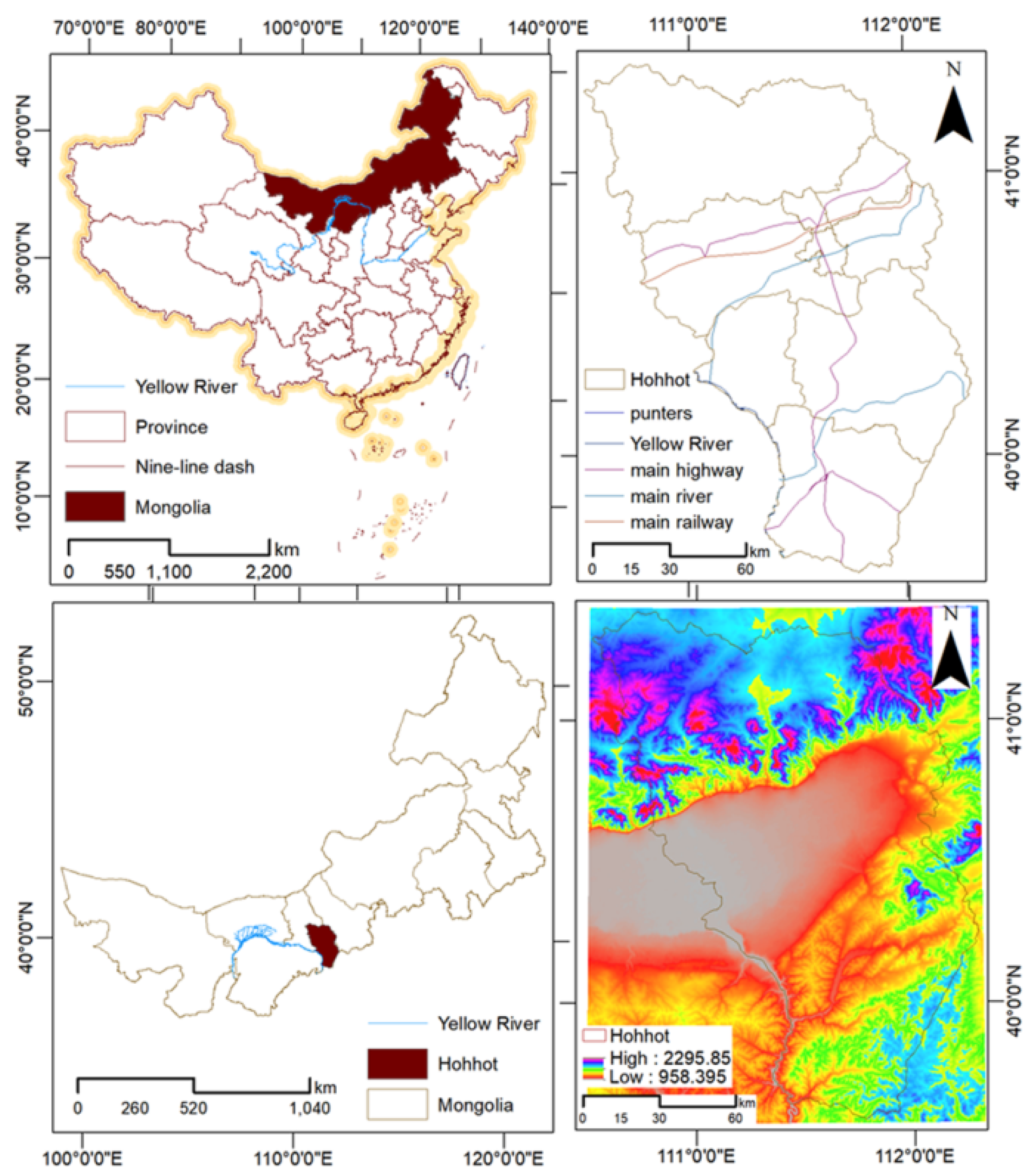
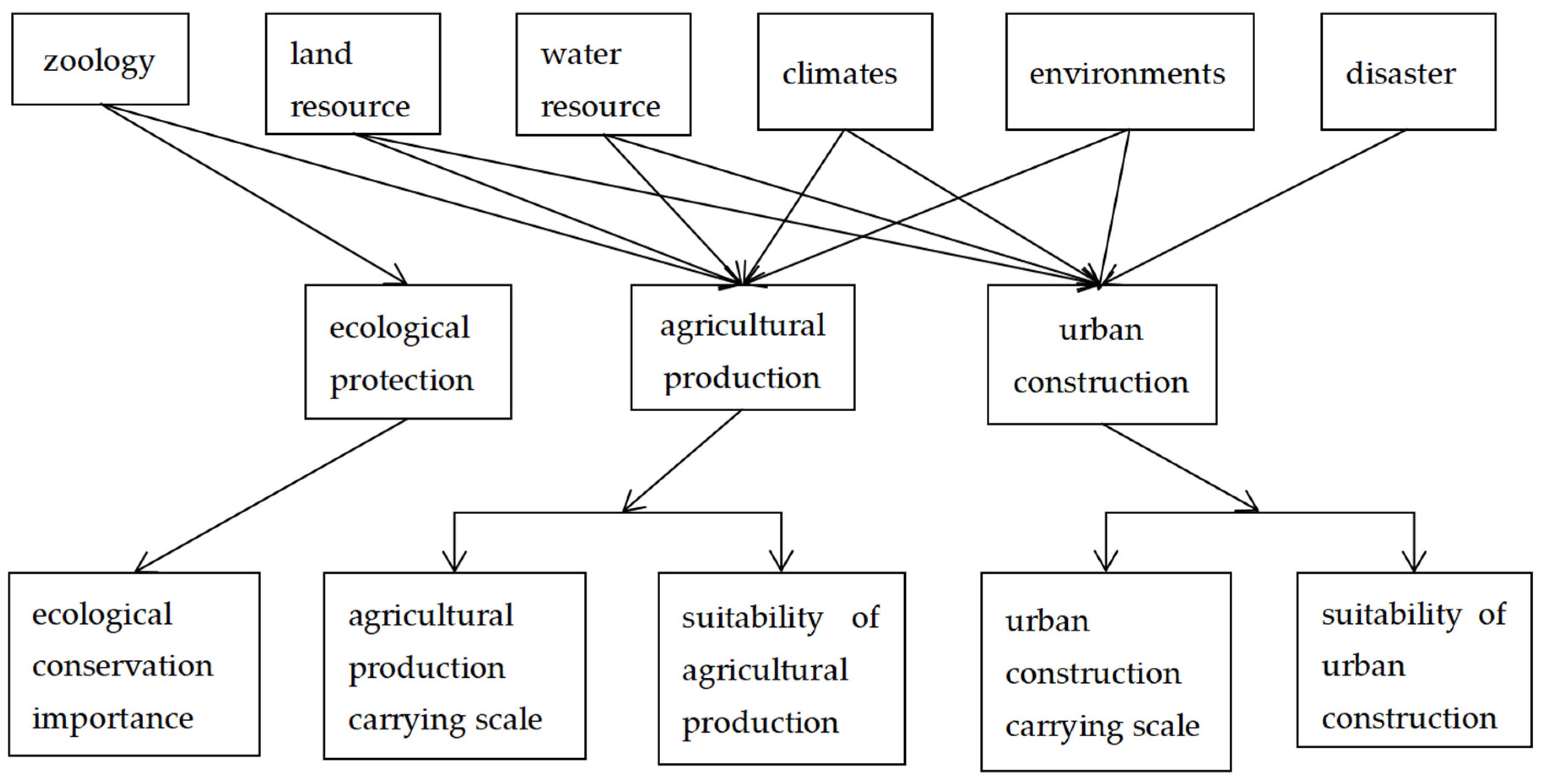
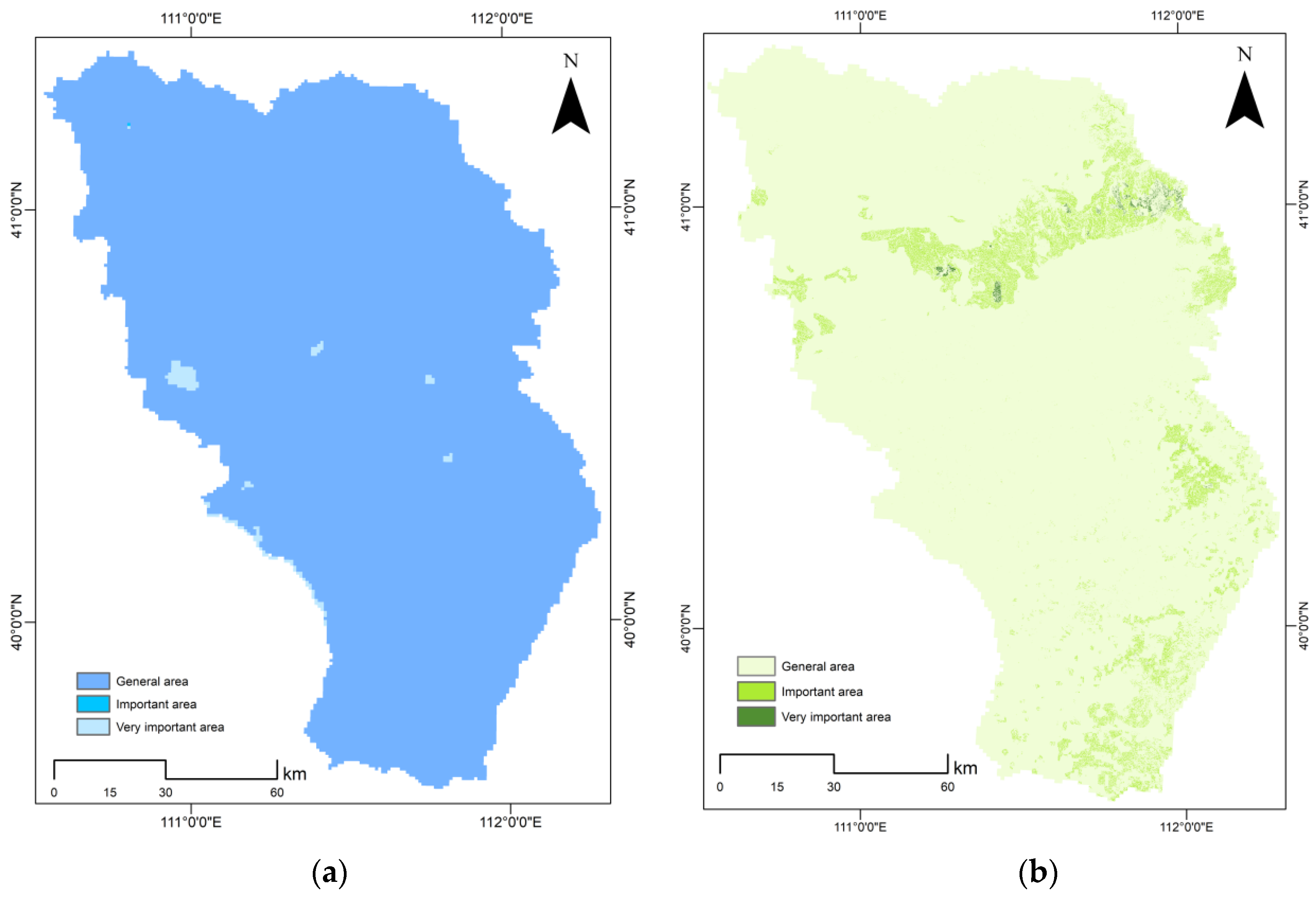
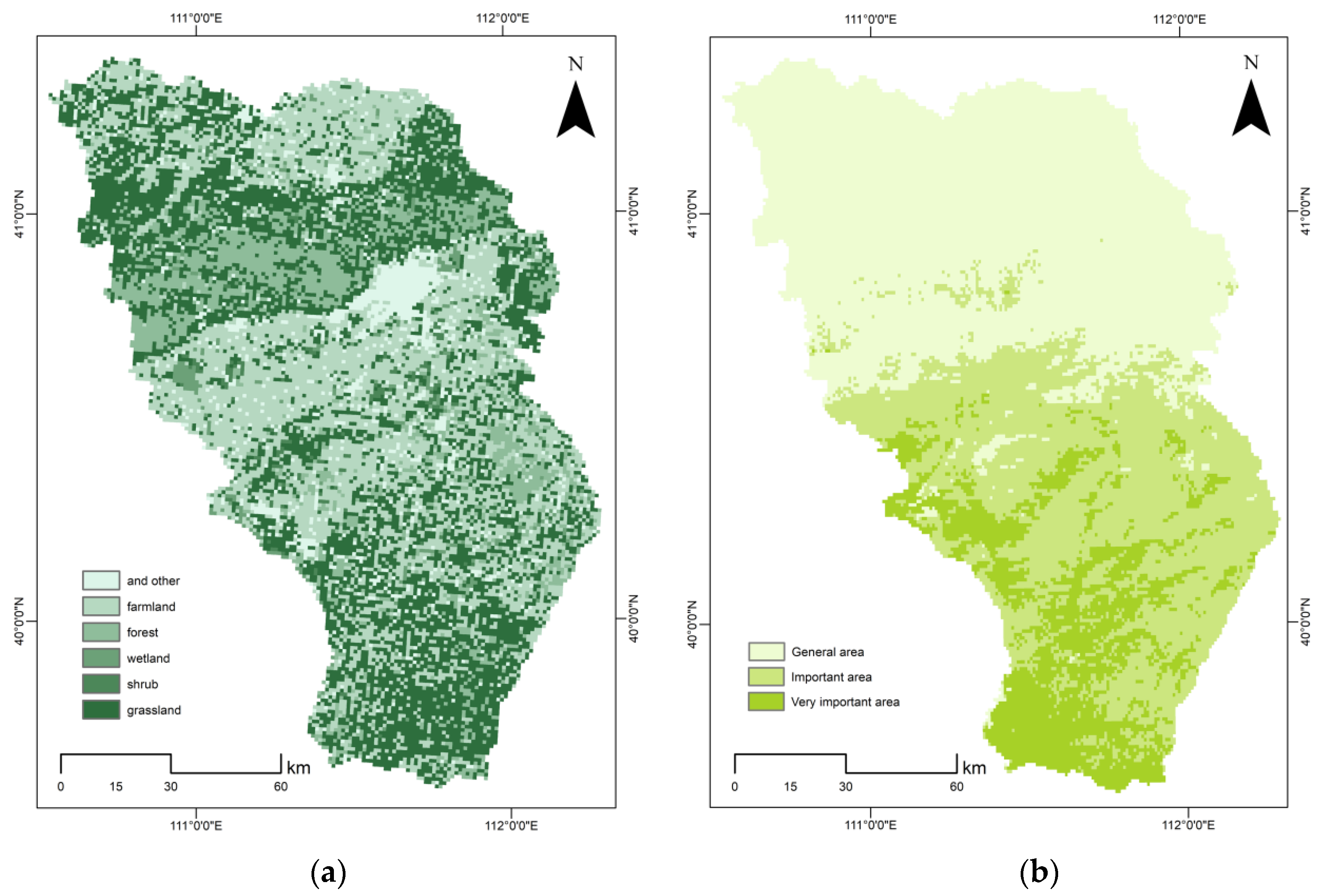
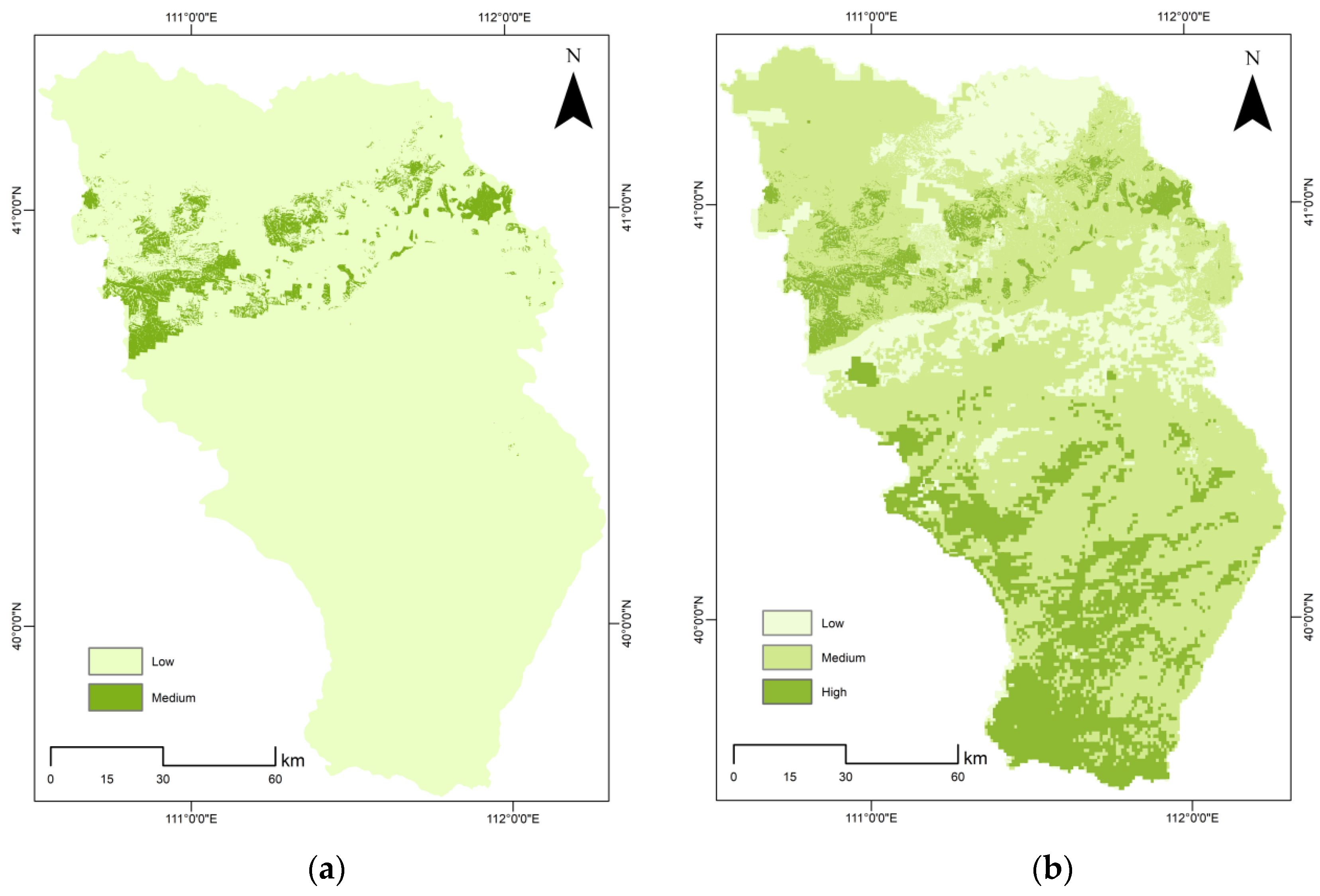
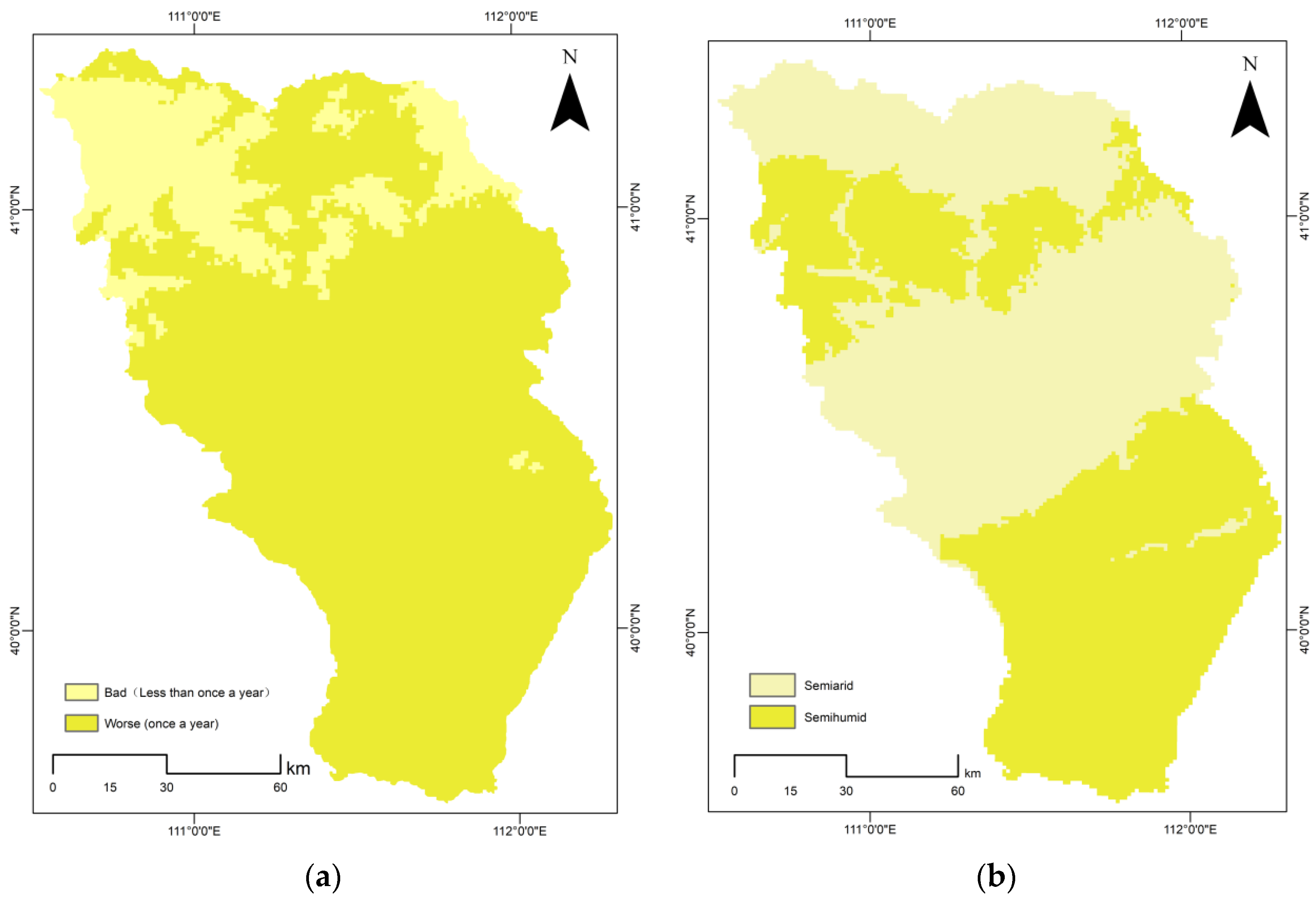
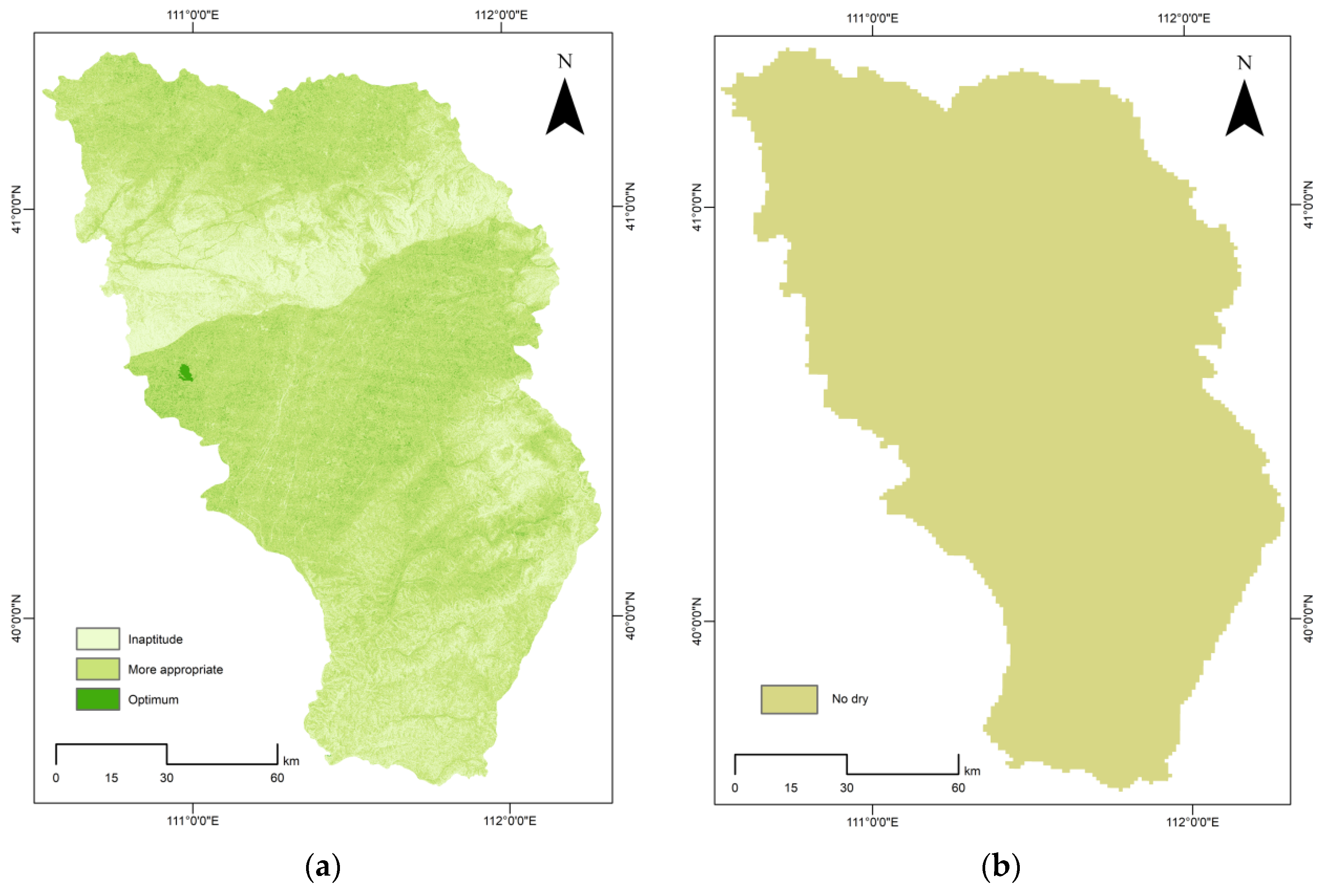

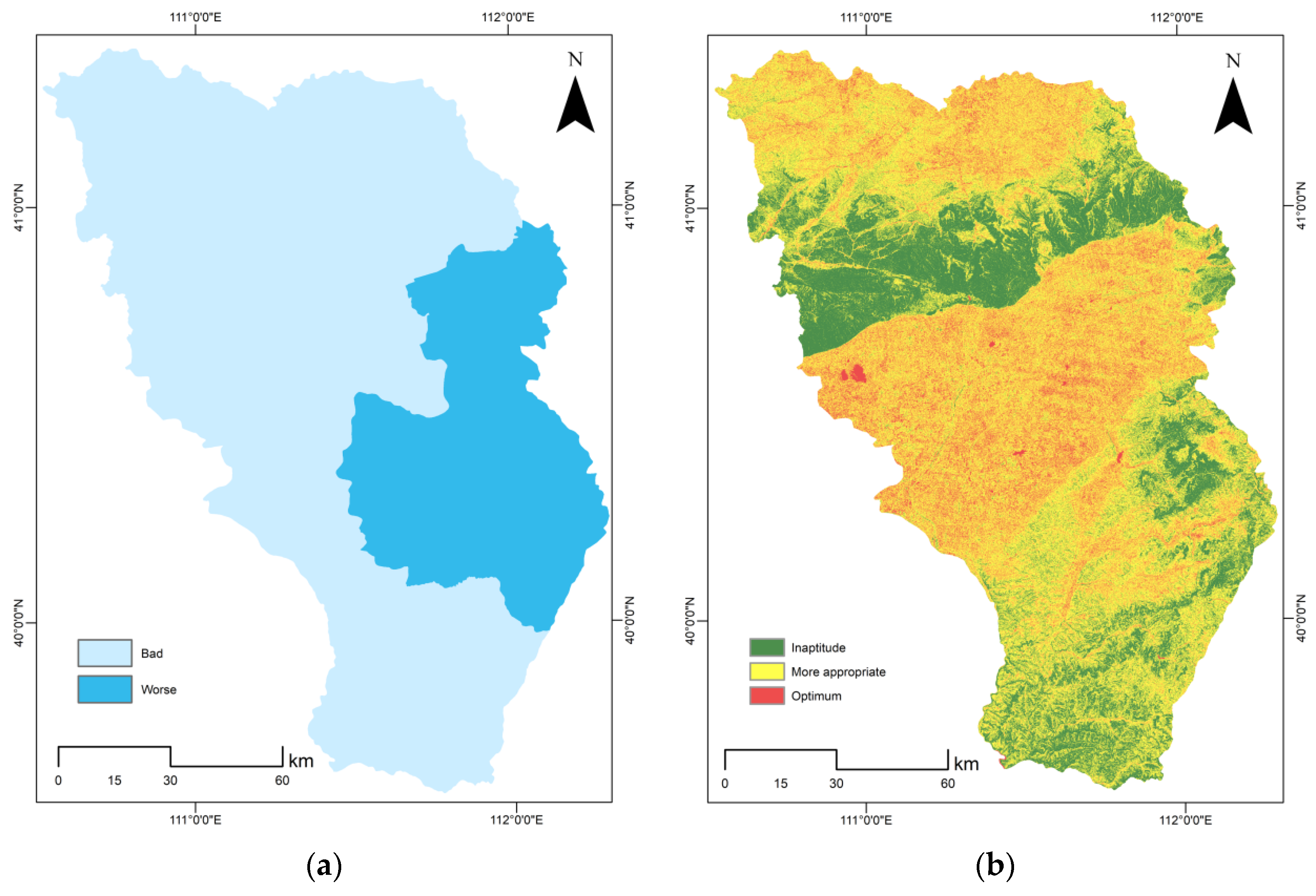
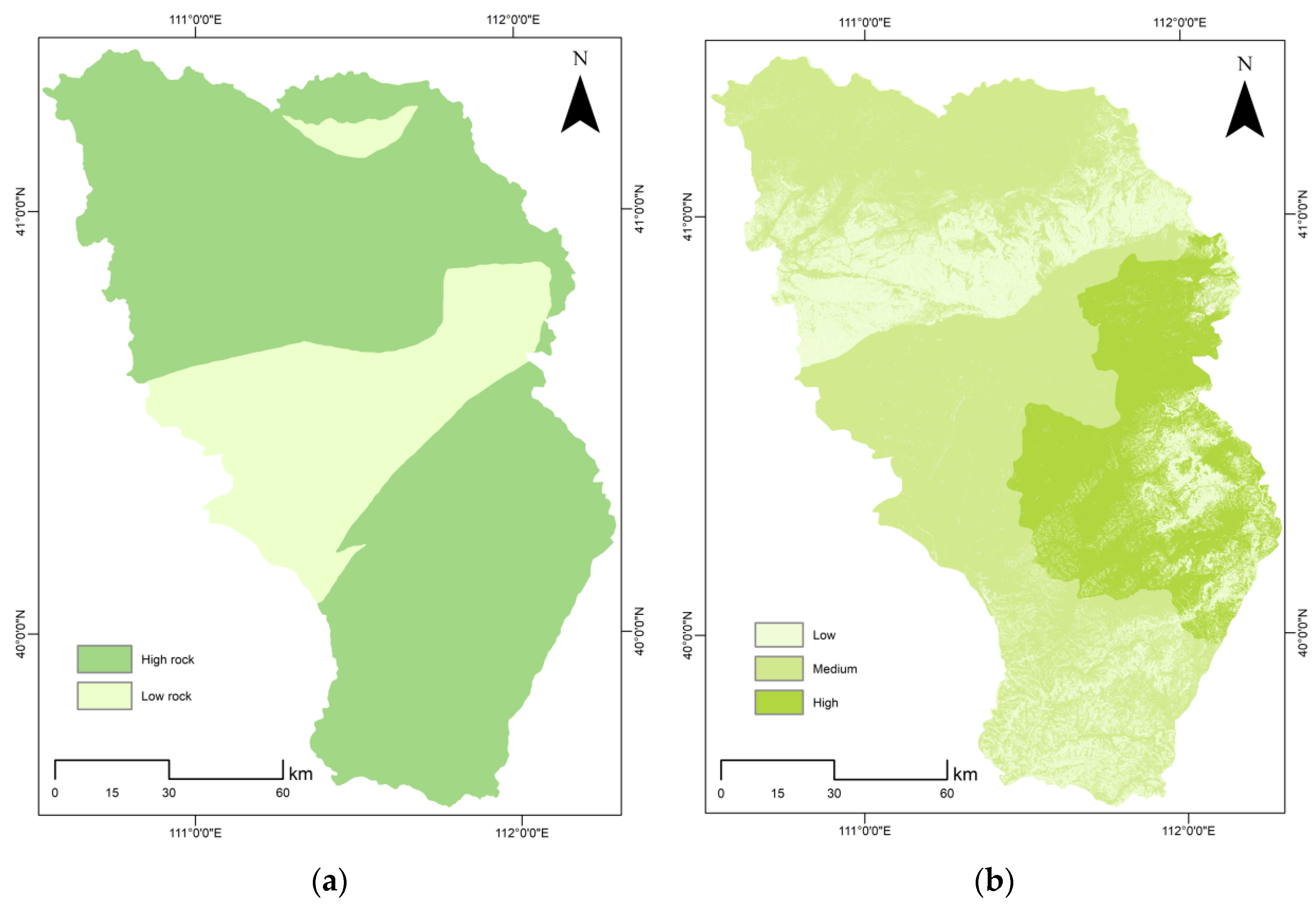

| Evaluation Dimension | Evaluation Content | Evaluating Indicator | Method of Calculation |
|---|---|---|---|
| Ecological protection evaluation | Ecosystem services | Water conservation function | [23] |
| Soil and water conservation function | [24] | ||
| Biodiversity | [25] | ||
| Ecological sensitivity | Soil erosion sensitivity | [26] | |
| Evaluation of agricultural function carrying capacity | Light and heat conditions | Light and heat conditions | |
| Foundation of water and land resources | Agricultural water supply conditions | [27] | |
| Land resources | [28] | ||
| Environmental capacity of soil | Drought agricultural disasters | ||
| Evaluation of urban functional carrying capacity | Foundation of water and land resources | Urban water supply conditions | |
| Topographic condition | |||
| Disaster potential | Geological hazard risk |
| Evaluation Dimension | Evaluation Content | Evaluating Indicator | Method of Calculation |
|---|---|---|---|
| Agricultural production suitability | Single factor of agricultural production suitability | Land resources | |
| Agricultural water supply conditions | |||
| Light and heat conditions | |||
| Drought agricultural disasters | |||
| Integrated evaluation | |||
| Suitability of urban construction | Single factor of urban construction suitability | Topographic condition | |
| Water supply condition | |||
| Geological hazard risk | |||
| Evaluation Factors | Hypersensitivity | Higher Sensitivity | Mid-Sensitive | Low Sensitivity | Lower Sensitivity |
|---|---|---|---|---|---|
| Rainfall erosivity | >600 | 400–600 | 100–400 | 25–100 | <25 |
| Soil erodibility | Sandy silt/silty soil | Sandy loam/silty clay/loamy clay | Surface sand/loam soil | Coarse sand/fine sandy soil/clay | Gravel/sand |
| Topographic relief | >300 | 100–300 | 50–100 | 20–50 | 0–20 |
| Vegetation cover | ≤0.2 | 0.2–0.4 | 0.4–0.6 | 0.6–0.8 | ≥0.8 |
| Classification | 9 | 7 | 5 | 3 | 1 |
Disclaimer/Publisher’s Note: The statements, opinions and data contained in all publications are solely those of the individual author(s) and contributor(s) and not of MDPI and/or the editor(s). MDPI and/or the editor(s) disclaim responsibility for any injury to people or property resulting from any ideas, methods, instructions or products referred to in the content. |
© 2023 by the authors. Licensee MDPI, Basel, Switzerland. This article is an open access article distributed under the terms and conditions of the Creative Commons Attribution (CC BY) license (https://creativecommons.org/licenses/by/4.0/).
Share and Cite
Chen, G.; Wang, S. Evaluation of Urban Resource Environmental Carrying Capacity and Land Spatial Development Suitability in a Semiarid Area of the Yellow River Basin. Sustainability 2023, 15, 12411. https://doi.org/10.3390/su151612411
Chen G, Wang S. Evaluation of Urban Resource Environmental Carrying Capacity and Land Spatial Development Suitability in a Semiarid Area of the Yellow River Basin. Sustainability. 2023; 15(16):12411. https://doi.org/10.3390/su151612411
Chicago/Turabian StyleChen, Guoqing, and Saifei Wang. 2023. "Evaluation of Urban Resource Environmental Carrying Capacity and Land Spatial Development Suitability in a Semiarid Area of the Yellow River Basin" Sustainability 15, no. 16: 12411. https://doi.org/10.3390/su151612411
APA StyleChen, G., & Wang, S. (2023). Evaluation of Urban Resource Environmental Carrying Capacity and Land Spatial Development Suitability in a Semiarid Area of the Yellow River Basin. Sustainability, 15(16), 12411. https://doi.org/10.3390/su151612411






